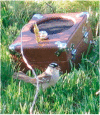Interspecific competition, hybridization, and reproductive isolation in secondary contact: missing perspectives on males and females
- PMID: 29492041
- PMCID: PMC5809030
- DOI: 10.1093/cz/zox060
Interspecific competition, hybridization, and reproductive isolation in secondary contact: missing perspectives on males and females
Abstract
Research on sexual selection and hybridization has focused on female mate choice and male-male competition. While the evolutionary outcomes of interspecific female preference have been well explored, we are now gaining a better understanding of the processes by which male-male competition between species in secondary contact promotes reproductive isolation versus hybridization. What is relatively unexplored is the interaction between female choice and male competition, as they can oppose one another or align with similar outcomes for reproductive isolation. The role of female-female competition in hybridization is also not well understood, but could operate similarly to male-male competition in polyandrous and other systems where costs to heterospecific mating are low for females. Reproductive competition between either sex of sympatric species can cause the divergence and/or convergence of sexual signals and recognition, which in turn influences the likelihood for interspecific mating. Future work on species interactions in secondary contact should test the relative influences of both mate choice and competition for mates on hybridization outcomes, and should not ignore the possibilities that females can compete over mating resources, and males can exercise mate choice.
Keywords: female–female competition; hybridization; male–male competition; reproductive isolation; sexual selection.
Figures



Similar articles
-
Linking intra- and interspecific assortative mating: Consequences for asymmetric sexual isolation.Evolution. 2016 Jun;70(6):1165-79. doi: 10.1111/evo.12939. Epub 2016 May 24. Evolution. 2016. PMID: 27151764
-
Experimental evidence for asymmetric mate preference and aggression: behavioral interactions in a woodrat (Neotoma) hybrid zone.BMC Evol Biol. 2013 Oct 4;13:220. doi: 10.1186/1471-2148-13-220. BMC Evol Biol. 2013. PMID: 24093823 Free PMC article.
-
Males and females contribute differently to the evolution of habitat segregation driven by hybridization.J Evol Biol. 2023 Mar;36(3):515-528. doi: 10.1111/jeb.14156. Epub 2023 Jan 31. J Evol Biol. 2023. PMID: 36721300
-
Female competition and its evolutionary consequences in mammals.Biol Rev Camb Philos Soc. 2011 May;86(2):341-66. doi: 10.1111/j.1469-185X.2010.00149.x. Biol Rev Camb Philos Soc. 2011. PMID: 20636474 Review.
-
An integrative view of sexual selection in Tribolium flour beetles.Biol Rev Camb Philos Soc. 2008 May;83(2):151-71. doi: 10.1111/j.1469-185X.2008.00037.x. Biol Rev Camb Philos Soc. 2008. PMID: 18429767 Review.
Cited by
-
Asymmetric interspecific competition drives shifts in signalling traits in fan-throated lizards.Proc Biol Sci. 2020 Dec 9;287(1940):20202141. doi: 10.1098/rspb.2020.2141. Epub 2020 Dec 9. Proc Biol Sci. 2020. PMID: 33290678 Free PMC article.
-
Reproductive Costs for Hybridizing Female Anasa tristis (Hemiptera: Coreidae), but No Evidence of Selection Against Interspecific Mating.J Insect Sci. 2018 Jul 1;18(4):17. doi: 10.1093/jisesa/iey080. J Insect Sci. 2018. PMID: 30165456 Free PMC article.
-
Male grey seal commits fatal sexual interaction with adult female harbour seals in the German Wadden Sea.Sci Rep. 2020 Aug 13;10(1):13679. doi: 10.1038/s41598-020-69986-w. Sci Rep. 2020. PMID: 32792537 Free PMC article.
-
Asymmetric reinforcement in Lucania killifish: assessing reproductive isolation when both sexes choose.Curr Zool. 2021 Apr;67(2):215-224. doi: 10.1093/cz/zoaa049. Epub 2020 Nov 30. Curr Zool. 2021. PMID: 33854539 Free PMC article.
-
Multiple mating in the context of interspecific hybridization between two Tetramorium ant species.Heredity (Edinb). 2020 May;124(5):675-684. doi: 10.1038/s41437-020-0310-3. Epub 2020 Mar 23. Heredity (Edinb). 2020. PMID: 32205865 Free PMC article.
References
-
- Abbott RJ, Barton NH, Good JM, 2016. Genomics of hybridization and its evolutionary consequences. Mol Ecol 25:2325–2332. - PubMed
-
- Albert AYK, Millar NP, Schluter D, 2007. Character displacement of male nuptial colour in threespine sticklebacks Gasterosteus aculeatus. Biol J Linn Soc 91:37–48.
-
- Allendorf FW, Leary RF, Spruell P, Wenburg JK, 2001. The problems with hybrids: setting conservation guidelines. Trends Ecol Evol 16:613–622.
-
- Alatalo RV, Gustafsson L, Lundberg A, 1994. Male coloration and species recognition in sympatric flycatchers. Proc R Soc Lond B 256:113–118.
LinkOut - more resources
Full Text Sources
Other Literature Sources
